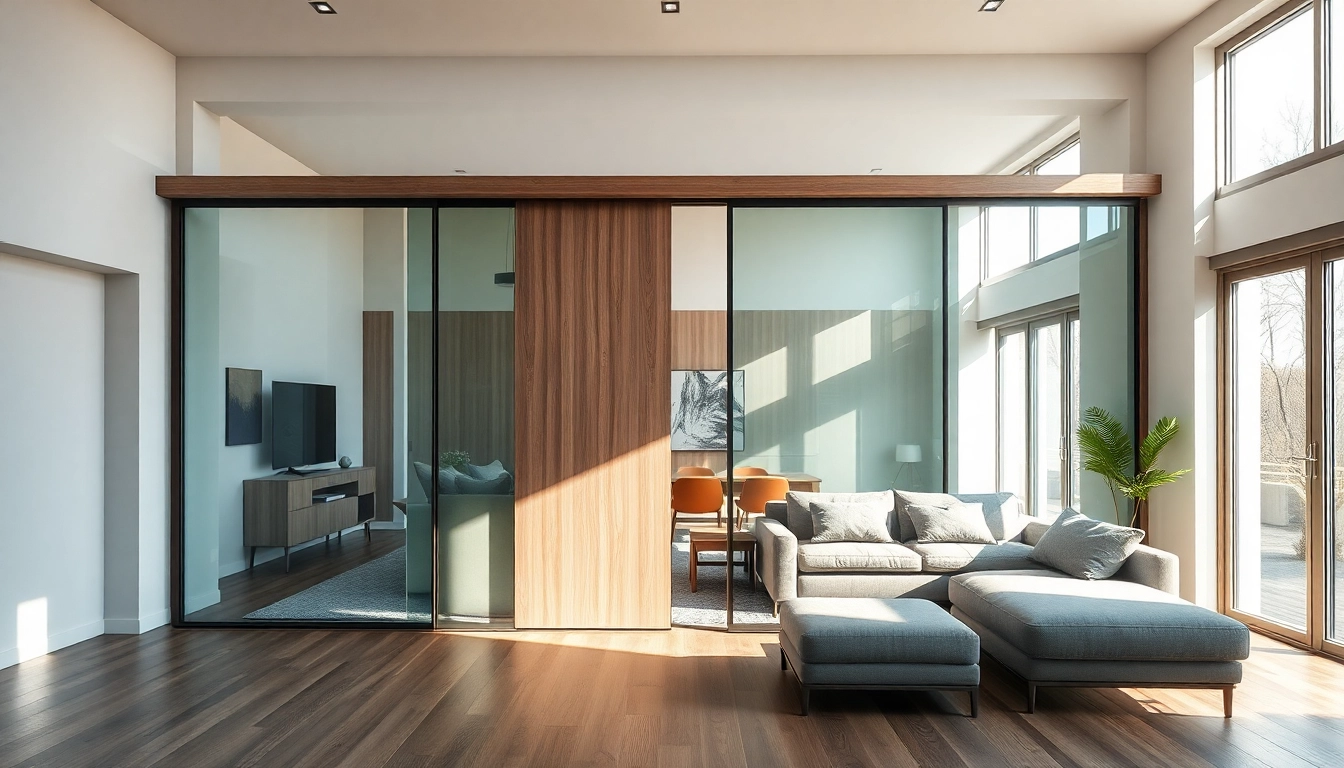What is a Sliding Partition Wall?
Definition and Purpose
A sliding partition wall is a versatile, movable wall system that allows for the flexible use of space in residential, commercial, and industrial settings. These walls can be opened or closed to create separate areas or to open up a larger space as needed. This dynamic approach to space management is particularly beneficial in environments where adaptability and multifunctionality are key, such as offices, conference rooms, or homes with open floor plans.
Types of Sliding Partition Walls
Sliding partition walls come in a variety of styles and constructions, each designed to meet specific needs. Here are some popular types:
- Operable Walls: These walls typically have a track system and can be fully opened to wall off portions of a space. They are commonly used in conference rooms or large auditoriums.
- Glass Sliding Walls: Made of transparent materials, these walls allow natural light to filter through, making them ideal for modern office spaces.
- Wooden or Fabric Sliding Panels: These provide an aesthetic touch and can be customized in terms of colors and textures, suitable for residential applications.
- Acoustic Partition Walls: Specifically designed to reduce sound transmission, these walls are crucial in environments where noise control is a priority, such as in educational or healthcare settings.
Benefits of Using Sliding Partition Walls
There are numerous advantages to incorporating sliding partition walls into your space:
- Space Efficiency: They maximize usable space by allowing areas to be adapted based on immediate needs.
- Cost-Effectiveness: Instead of costly renovations or additions, sliding walls provide a more affordable way to create separate areas.
- Flexibility: The easy operation of sliding walls allows users to reconfigure spaces quickly, making them ideal for multi-functional areas.
- Aesthetic Appeal: Available in various materials and finishes, sliding partition walls can enhance the look of any room while offering functionality.
Key Features of Sliding Partition Walls
Design Options and Materials
Sliding partition walls are customizable to fit any interior design style. Key materials include:
- Wood: Ideal for traditional and rustic settings. Wood can be stained or painted to match existing decor.
- Glass: Perfect for modern aesthetics, glass walls provide transparency and openness while still allowing for privacy when needed.
- Fabric: Often used for acoustic panels, fabric can add warmth and color to a room while serving functional purposes.
- Metal: Often used in commercial applications for durability and a sleek finish.
Mechanisms of Operation
The mechanisms that empower sliding partition walls vary widely, impacting both functionality and ease of use:
- Track Systems: Most sliding walls operate on ceiling- or wall-mounted tracks, allowing smooth movement. Options vary from single tracks for lightweight panels to complex multi-track systems for larger walls.
- Telescoping Mechanisms: Some systems feature telescoping capabilities that allow panels to fold and stack neatly, maximizing space when opened.
- Manual vs. Automatic: While many sliding walls are manually operated, there are automated systems available that can be controlled with the press of a button, which is especially useful in commercial settings.
Customization Potential
Customization enhances the utility and appeal of sliding partition walls. Options for customization include:
- Size: Walls can be tailored to fit any space, whether large or small.
- Finish: From matte to gloss, different finishes can complement any interior.
- Soundproofing: Acoustic treatments can be integrated to improve sound control in busy environments.
- Smart Features: Some modern designs allow for integration with smart home systems for automated operation.
Installing a Sliding Partition Wall
Preparation and Planning
Installing a sliding partition wall requires thorough preparation and planning. Key steps include:
- Space Measurement: Accurate measurements are crucial. Consider ceiling height and width to determine the appropriate size.
- Weight Capacity: Ensure that the wall and track systems are suitable for the intended use and weight of the partition.
- Design Considerations: Factor in design aesthetics to ensure that the wall complements existing decor.
Step-by-Step Installation Guide
Here is a simplified step-by-step guide to installing a sliding partition wall:
- Gather Tools and Materials: Ensure you have all necessary tools such as a stud finder, level, drill, and screws.
- Prepare the Track: Attach the track to the ceiling, ensuring it is level and securely fixed. If necessary, seek out stud locations for added support.
- Install Wall Panels: Hang the panels using the track, ensuring that they glide smoothly.
- Test the Mechanism: Before finalizing the installation, test the movement of the panels to ensure they function as intended.
Common Installation Challenges
During installation, you may encounter specific challenges that can arise:
- Misalignment: Ensure that tracks are level and correctly aligned. Use a level to verify.
- Inadequate Support: Ensure that structures can support the weight of the walls, especially for heavy materials like glass.
- Space Constraints: In tight spaces, planning for the proper opening and closure of the panels is crucial to functionality.
Maintenance and Care for Sliding Partition Walls
Regular Cleaning and Upkeep
To maintain the functionality and aesthetic appeal of sliding partition walls, regular maintenance is essential. Here are some tips:
- Cleaning Tracks: Dust and debris can affect movement. Regularly clean the track systems to ensure smooth operation.
- Panel Cleaning: The material type will determine how to clean panels. Most glass and wood surfaces can be wiped down with appropriate cleaners.
- Routine Inspections: Regularly check for any signs of wear or loose fittings to address issues before they become major problems.
Troubleshooting Common Issues
Things may occasionally go wrong. Common issues and their solutions include:
- Stiff Movement: If the wall is difficult to slide, check for obstructions in the track or debris that may be causing friction.
- Noise During Operation: Noises could indicate a lack of lubrication or potential misalignment in the track. Ensure all hardware is secured and lubricate if necessary.
- Wear and Tear: Regular inspections can help catch any potential wear before it escalates. Replace components as necessary.
When to Call a Professional
Certain situations warrant the help of a professional installer:
- Complex Systems: For advanced or automated sliding walls, it may be best to consult a professional for installation and programming.
- Heavy Structural Changes: If installation requires significant modifications to the structure, professional guidance is advisable.
- Persistent Issues: If problems persist despite troubleshooting efforts, professional assessment can provide effective solutions.
Real-Life Applications and Inspiration
Residential Use Cases
In residential settings, sliding partition walls can enhance livability and style:
- Open Concept Living: They allow homeowners to segment large spaces for dining or entertaining without permanent changes.
- Home Offices: With more people working from home, sliding walls can create a quiet workspace that can be closed off after hours.
- Flexible Family Rooms: Sliding walls can adapt to changing family needs, transforming a play area into a guest room in minutes.
Commercial Applications
In the commercial sector, sliding partition walls are invaluable:
- Workspaces: They allow for quick adjustments in open office layouts, creating collaborative spaces or private meeting areas as needed.
- Event Venues: Sliding walls can change the size of event spaces to accommodate different group sizes, enhancing function and aesthetics during events.
- Hospitality: Restaurants and hotels use sliding partitions to separate dining areas or conference rooms, providing flexible seating arrangements.
Innovative Design Ideas
Innovative uses of sliding partition walls can greatly enhance the usability and design of a space:
- Biophilic Design: Incorporating living plant walls into sliding partitions can enhance aesthetics while improving air quality.
- Multimedia Walls: Integrating technology into partitions for projection screens or interactive displays enriches user experience in educational and corporate settings.
- Artistic Panels: Custom artwork or decorative designs can transform functional walls into stunning focal points in corporate lobbies or residential spaces.



